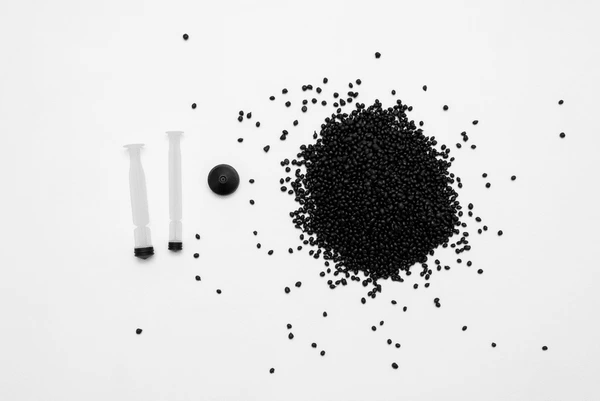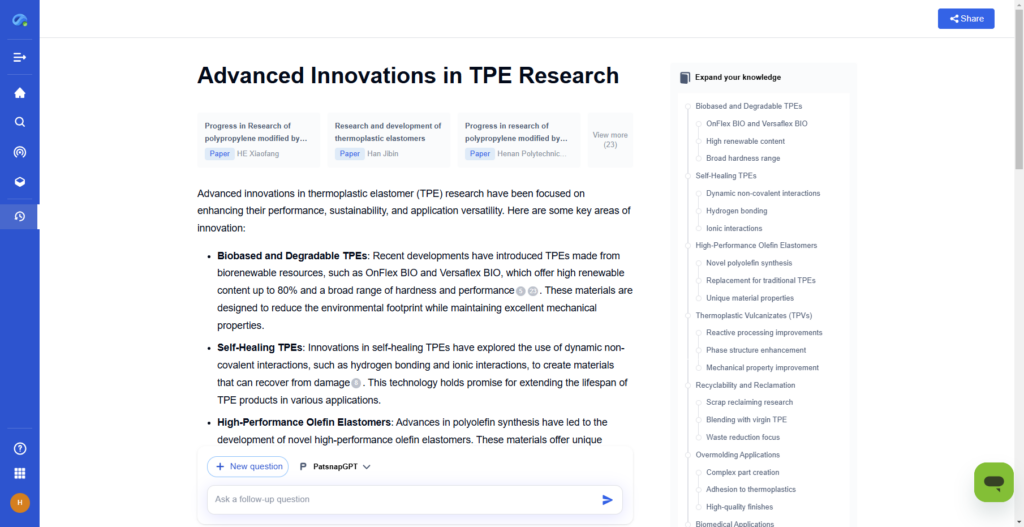
Introduction
Thermoplastic Elastomers (TPEs) have revolutionized the materials industry by combining the best features of thermoplastics and elastomers. Their ability to be processed like plastic while retaining rubber-like flexibility makes them ideal for diverse applications, from automotive and medical devices to consumer goods.
With advancements in AI-driven research platforms like Eureka by PatSnap, R&D teams can now accelerate material discovery, optimize formulations, and enhance performance prediction for TPEs. This article explores the properties, classifications, applications, and future developments of TPEs.

What is TPE?
TPE (Thermoplastic Elastomer) is a class of copolymers or physical mixtures of polymers that exhibit both thermoplastic and elastomeric properties. Unlike conventional thermoset rubber, TPEs can be melted, reshaped, and recycled, making them highly versatile and sustainable.
Key Characteristics of TPE:
- Elasticity & Flexibility: Retains rubber-like flexibility and resilience.
- Thermoplastic Behavior: Can be melted and reshaped, allowing easy processing.
- Chemical Resistance: Excellent resistance to oils, chemicals, and UV radiation.
- Recyclability: Unlike thermoset rubbers, TPEs are fully recyclable.
- Wide Hardness Range: Available in Shore A to Shore D hardness scales.
Types of TPE and Their Properties
TPEs can be classified into several categories based on their chemical composition and performance characteristics:
1. Styrenic Block Copolymer (SBC) TPE
Properties:
- Flexibility: Provides rubber-like flexibility while being easy to process.
- Hardness Range: Offers a broad range of hardness, from soft and flexible to hard and rigid, making it highly customizable.
- Transparency: SBC-based TPEs are often clear or transparent, making them suitable for applications where aesthetics are important.
- Good Processability: Can be processed using conventional thermoplastic methods, such as extrusion and injection molding.
Common Applications:
- Footwear soles
- Sealants and gaskets
- Medical devices and toys
Pros:
- Easy to process
- Excellent balance of flexibility and rigidity
- Good transparency
2. Thermoplastic Polyurethane (TPU)
Properties:
- Durability: Known for its high resistance to abrasion, oils, and chemicals.
- High Elasticity: Offers outstanding elasticity and wear resistance.
- Wide Hardness Range: Can be formulated with a wide range of hardness, making it highly adaptable.
- Tensile Strength: TPU boasts high tensile strength, which contributes to its long-lasting performance even in demanding environments.
Common Applications:
- Automotive parts (such as gaskets and seals)
- Sports equipment (like protective gear and footwear)
- Medical devices (including tubing and catheters)
Pros:
- Superior durability and wear resistance
- Excellent chemical and oil resistance
- Versatile hardness range

3. Thermoplastic Vulcanizates (TPV)
Properties:
- Rubber-Like Performance: TPVs exhibit the same performance as vulcanized rubber but can be processed like thermoplastics.
- High Thermal Resistance: TPVs perform well at higher temperatures compared to other TPE types.
- Excellent Compression Set Resistance: TPVs maintain their shape and elasticity under compression, making them ideal for sealing applications.
- Improved Oil Resistance: Offers better oil and fuel resistance than many other TPEs.
Common Applications:
- Automotive seals and gaskets
- Electrical cable jacketing
- Industrial components exposed to heat and chemicals
Pros:
- Rubber-like performance
- Excellent compression set resistance
- High temperature and oil resistance
4. Thermoplastic Olefins (TPO)
Properties:
- Lightweight: TPO materials are lighter than many other elastomeric materials.
- Weatherability: Known for excellent resistance to UV radiation, oxidation, and harsh environmental conditions.
- Chemical Resistance: TPO offers high resistance to chemicals and moisture, making it ideal for outdoor applications.
- Good Stiffness: Provides a balance of rigidity and flexibility depending on the grade and formulation.
Common Applications:
- Automotive parts (bumpers, instrument panels)
- Roofing membranes
- Industrial applications requiring resistance to weather and chemicals
Pros:
- Good chemical and weather resistance
- Lightweight
- Durable in harsh environments
5. Elastomeric Alloys (EA)
Properties:
- Exceptional Softness: EA TPEs can be very soft and flexible, offering superior comfort in applications like seals and medical products.
- Cost-Effective: Compared to some other TPE types, EA TPEs are often more economical.
- Good UV Resistance: Offers decent resistance to ultraviolet (UV) light, ensuring durability in outdoor settings.
- Processable at Low Temperatures: Can be processed easily at lower temperatures compared to other TPEs, offering energy savings.
Common Applications:
- Medical devices (such as soft-touch handles)
- Automotive seals
- Consumer goods (such as grips for tools)
Pros:
- Soft and comfortable
- Economical
- Good UV resistance
6. Copolyester TPE (COPE)
Properties:
- High Chemical Resistance: Copolyester TPEs exhibit excellent resistance to harsh chemicals, oils, and solvents.
- High Heat Resistance: Capable of withstanding higher temperatures than many other TPE types.
- Transparency and Clarity: Some COPE materials are highly transparent, offering aesthetic appeal for consumer-facing products.
- Excellent Impact Resistance: Provides good impact resistance and toughness in applications requiring high performance under stress.
Common Applications:
- Food and beverage containers
- Medical devices
- Consumer electronics
Pros:
- Superior chemical resistance
- High temperature and impact resistance
- Good transparency
Applications of TPE in Different Industries

TPEs are widely used across multiple industries due to their versatility.
Automotive Industry
- Interior Components: Soft-touch dashboards, door seals, and weatherstrips.
- Exterior Parts: Bumpers, protective moldings, and under-the-hood components.
- Sustainability Benefits: Recyclability reduces environmental impact.
Medical and Healthcare
- Medical Tubing & Catheters: Biocompatibility and sterilizability.
- Wearable Devices: Soft and skin-friendly formulations.
- FDA-Approved Materials: Compliance with medical-grade regulations.
Consumer Goods & Electronics
- Soft-Touch Grips: Found in toothbrushes, tools, and pens.
- Wearables: Flexible TPE materials for smartwatches and fitness bands.
- Seals & Gaskets: Waterproofing solutions in electronics.
Industrial & Construction
- Hoses & Belts: High-performance TPEs replace traditional rubber.
- Wire Insulation: Excellent electrical properties and durability.
- 3D Printing: Flexible filament options for prototyping and production.
Advanced Innovations in TPE Research
AI-Driven Material Discovery
With platforms like Eureka by PatSnap, R&D teams can leverage AI to:
- Identify novel TPE formulations.
- Predict mechanical and thermal properties.
- Analyze patents and scientific literature for competitive insights.
Sustainable & Bio-Based TPEs
- Development of bio-based TPEs from renewable resources like soybean oil and corn starch.
- Enhanced recyclability to support a circular economy.
- Lower carbon footprint compared to traditional petroleum-based elastomers.
High-Performance TPEs for Extreme Environments
- Flame-Retardant TPEs: Used in aerospace and electrical industries.
- High-Temperature Resistant TPEs: Operate up to 150°C – 200°C.
- Superhydrophobic TPEs: Self-cleaning and water-resistant properties.

Choosing the Right TPE for Your Application
Key Factors to Consider:
- Mechanical Properties: Tensile strength, elongation, and impact resistance.
- Chemical Compatibility: Resistance to oils, solvents, and UV radiation.
- Processing Method: Injection molding, extrusion, or 3D printing.
- Regulatory Compliance: FDA, REACH, RoHS certifications.
For businesses looking to streamline material selection, Eureka by PatSnap offers an AI-powered solution to analyze patents, materials, and global trends, ensuring optimal TPE selection.
Conclusion
Thermoplastic Elastomers (TPEs) have transformed industries with their unique combination of elasticity, recyclability, and processability. With continuous innovations in bio-based TPEs, high-performance applications, and AI-driven research, the future of TPEs looks promising.
R&D professionals can leverage AI-powered platforms like Eureka by PatSnap to accelerate material discovery, optimize performance, and gain a competitive edge in the evolving landscape of polymer science.
FAQs
1. What are the key advantages of TPE over traditional rubber?
TPE offers superior recyclability, easier processing, and lower production costs compared to thermoset rubber.
2. Can TPE be used in high-temperature applications?
Yes, some high-performance TPEs can withstand temperatures up to 200°C, making them suitable for automotive and industrial uses.
3. Is TPE environmentally friendly?
Many TPEs are recyclable, and recent advancements in bio-based TPEs contribute to sustainability efforts.
4. How does AI help in TPE material research?
AI platforms like Eureka by PatSnap analyze patents, material properties, and market trends, helping researchers optimize TPE formulations.
5. What are some emerging trends in TPE technology?
Key trends include sustainable bio-based TPEs, superhydrophobic coatings, and high-performance elastomers for extreme conditions.
Would you like an SEO-optimized image to complement this article? Let me know! 🚀
To get detailed scientific explanations of Thermoplastic Elastomers, try Patsnap Eureka.

